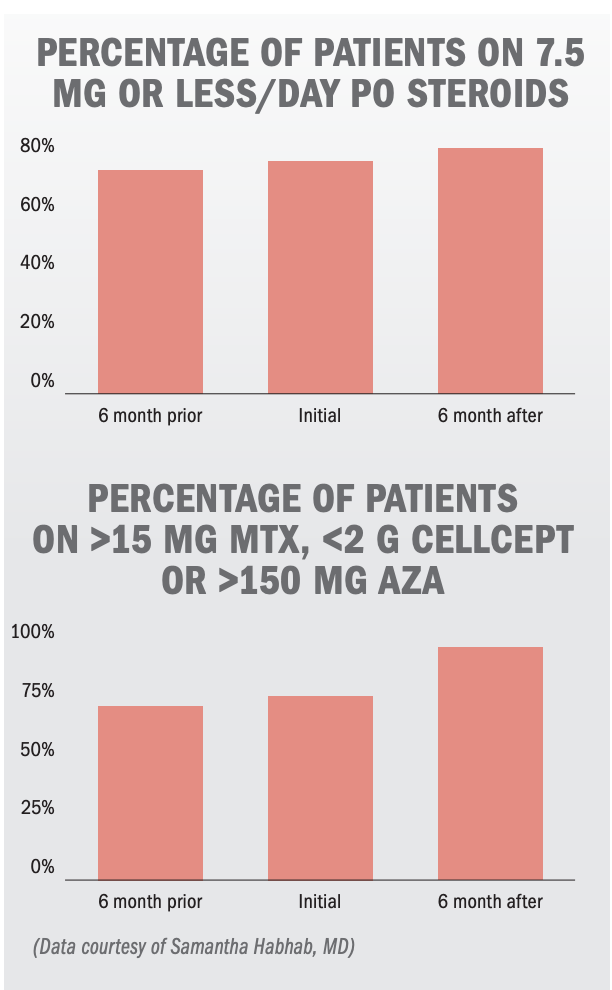Results from ophthalmology/rheumatology clinic treating uveitis from Ophthalmology Times
June 14, 2021
Reviewed by Samantha Habhab, MD; and Xihui Lin, MD
A dual approach to managing uveitis with simultaneous evaluations by ophthalmologists and rheumatologists resulted in improvements in visual acuity (VA) after 6 months and favorable improvements in oral steroid needs and adherence to steroid-sparing immunomodulatory therapy (IMT), according to Samantha Habhab, MD, a resident in ophthalmology at Kresge Eye Institute, Wayne State University School of Medicine, Detroit.
Uveitis is managed medically with topical and systemic steroids and steroid-sparing IMT, but these patients require a multidisciplinary approach with both an ophthalmologist and rheumatologist to monitor systemic disease activity and tolerance to systemic therapy.
Related: Uveitis: A leading, underestimated cause of visual morbidity in patients
A concern with this separate management approach is the frequent evaluations required, which often result in poor communication between providers and poor patient follow-up.
The Kresge Eye Institute took a step forward in the management of this patient population with the establishment in July 2018 of an outpatient combined ophthalmology/rheumatology uveitis clinic under the leadership of Xihui Lin, MD, and Ilyes Benchaala, MD, which is perhaps one of the first such clinics in the country.
Lin is an ophthalmologist and Benchaala is a rheumatologist at Kresge Eye Institute.
Habhab and associates conducted a retrospective cohort study to evaluate the 6-month outcomes using the combined clinic scenario.
The primary outcomes were the best-corrected visual acuity (BCVA), level of inflammation, and achievement of target-dose steroid therapy and IMT.
Patients with uveitis were included who had been evaluated 6 months before the initial visit to the combined uveitis clinic and then compared with 6 months after the initial combined clinic visit.
Related: Tackling the challenge of noninfectious uveitis

The targeted dose of steroid use was 7.5 mg/day or lower; the targeted doses of IMT were methotrexate more than 15 mg/week, mycophenolate mofetil (CellCept; Genentech) exceeding 2 g daily, azathioprine exceeding 150 mg daily, and all other IMT at any dose.
Findings
Eighty-five patients (64.6% women; average age, 52.7 years) were included in the study. The uveitis types were panuveitis in 47.1%, anterior uveitis in 22.4%, posterior uveitis in 18.8%, scleritis in 8.2%, and intermediate uveitis in 3.5%.
Most cases (37.5%) were idiopathic. Sarcoidosis and rheumatoid arthritis were associated with the highest prevalence of noninfectious uveitis in 16.5% and 12.9% of cases, respectively, followed by fewer cases of human leukocyte antigen B27, multiple sclerosis, Vogt-Koyanagi-Harada disease, systemic lupus erythematosus, juvenile idiopathic arthritis, and Behçet disease.
Tuberculosis (5.9%) and syphilis and toxoplasmosis (3.5% each) were associated with infectious uveitis.
Related: Evaluating 3-year-recurrence rate in non-infectious posterior segment veitis post-FAi
Habhab reported that the VA improved significantly (P = .002) from 0.61 logMAR before the combined clinic was established to 0.50 logMAR at 6 months after management in the combined uveitis clinic.
The investigators observed a decreasing nonsignificant trend in anterior chamber cells from 6 months before to 6 months after combined clinic establishment.
Anterior chamber flare showed a significant (P = .0002) decline from 0.57 to 0.23 at the later time point. The degree of vitreous haze remained stable, with a slight nonsignificant trend toward increased haze at the later time point.
The use of oral steroids decreased significantly (P = .008) from 77.5% to 59.5% following combined clinic establishment. The rate of use of IMT increased from 38.6% to 55.2% at the later date.
The use of steroids at a daily dose of 7.5 mg or less increased to 79.1% of patients; the use of IMT also increased to 87.5% of patients at the targeted dose.
Related: Antibiotic-steroid combination boosts confidence with delivery
“Our data showed that the establishment of a combined uveitis clinic led to significant improvement in VA after 6 months and favorable improvements in oral steroid requirements and steroid-sparing therapy adherence,” Habhab said. “Aside from anterior chamber flare, the level of inflammation did not appear to change significantly when we compared the 6-month data before the clinic was established with that 6 months after the clinic was established.”
Habhab concluded that the study highlighted the benefits of collaborative, simultaneous care between ophthalmologists and rheumatologists and the potential for improved outcomes in patients with uveitis.
“Future directions include a longer follow-up period, which would allow better assessment of outcome after a longer duration of therapy,” she said.
Read, “Results from ophthalmology/rheumatology clinic treating uveitis” from Ophthalmology Times.
Make an appointment with a Wayne Health eye doctor at Kresge Eye Institute.
